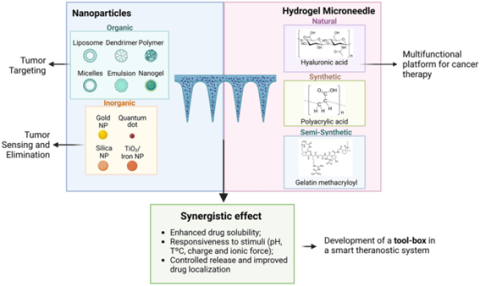Due to the severity and high prevalence of cancer, as well as its complex pathological condition, new strategies for cancer treatment and diagnostics are required. As such, it is important to design a toolbox that integrates multiple functions on a single smart platform. Theranostic hydrogels offer an innovative and personalized method to tackle cancer while also considering patient comfort, thereby facilitating future implementation and translation to the clinic. In terms of theranostic systems used in cancer therapy, nanoparticles are widely used as diagnostic and therapeutic tools. Nanoparticles can achieve systemic circulation, evade host defenses, and deliver drugs and signaling agents at the targeted site, to diagnose and treat the disease at a cellular and molecular level. In this context, hydrogel microneedles have a high potential for multifunctional operation in medical devices, while avoiding the complications associated with the systemic delivery of therapeutics. Compared with oral administration and subcutaneous injection, microneedles offer advantages such as better patient compliance, faster onset of action, and improved permeability and efficacy. In addition, they comprise highly biocompatible polymers with excellent degradability and tunable properties. Nanoparticles and microneedles thus offer the possibility to expand the theranostic potential through combined synergistic use of their respective features. We review herein recent advances concerning processing methods and material requirements within the realm of hydrogel microneedles as theranostic platforms, various approaches toward cancer therapy, and the incorporation of nanoparticles for added functionality.

